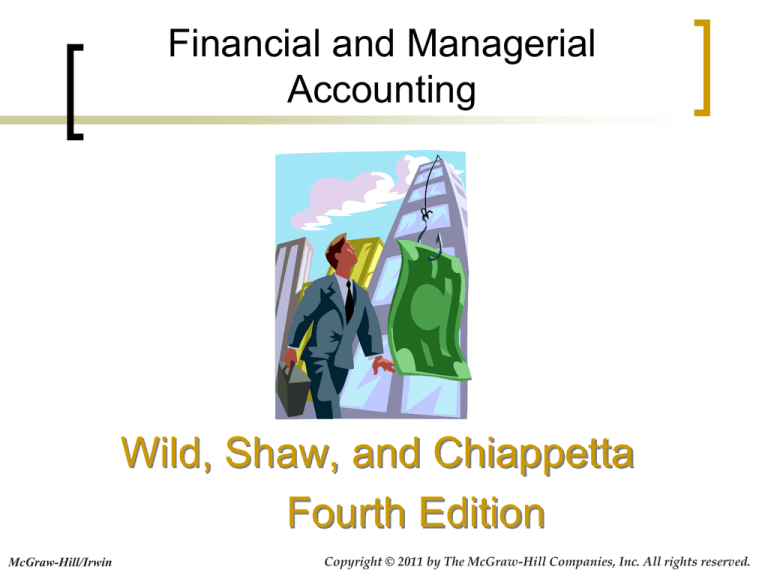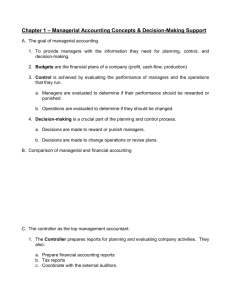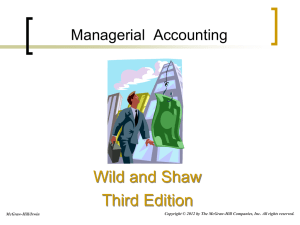
Financial and Managerial
Accounting
Wild, Shaw, and Chiappetta
Fourth Edition
McGraw-Hill/Irwin
Copyright © 2011 by The McGraw-Hill Companies, Inc. All rights reserved.
Chapter 14
Managerial Accounting
Concepts and Principles
Conceptual Learning Objectives
C1: Explain the purpose and nature of managerial
accounting and the role of ethics.
C2: Describe accounting concepts useful in classifying
costs.
C3: Define product and period costs and explain how
they impact financial statements.
C4: Explain how the balance sheets and income
statements for manufacturing and merchandising
companies differ.
C5: Explain manufacturing activities and the flow of
manufacturing costs.
C6: Identify trends in managerial accounting.
14-3
Analytical Learning Objectives
A1: Compute cycle time and cycle
efficiency, and explain their importance
to production management.
14-4
Procedural Learning Objectives
P1: Compute cost of goods sold for a
manufacturer.
P2: Prepare a manufacturing statement
and explain its purpose and links to
financial statements.
14-5
C1
Managerial and Financial
Accounting
Managerial accounting
provides financial and
non-financial information
for managers of an
organization and other
decision makers
Financial accounting
provides general
purpose financial
information to those
who are outside
the organization.
14-6
Nature of Managerial
Accounting
C1
Financial Accounting
Managerial Accounting
Investors, creditors and
other external users
Managers, employees and
other internal users
2. Purpose of
information
Making investment, credit
Planning and
and other decisions
control decisions
3. Flexibility
of practice
Structured and often
Relatively flexible
controlled by GAAP
(no GAAP constraints)
4. Timeliness of
information
Often available only
Available quickly without
after audit is complete
need to wait for audit
Historical information
with some predictions
Many projections
and estimates
Emphasis on
Projects, processes and
whole organization
segments of an organization
Monetary
Monetary and
information
nonmonetary information
1. Users and
decision makers
5. Time dimension
6. Focus of
information
7. Nature of
information
14-7
C2
Managerial Cost Concepts
Behavior
Traceability
Controllability
Relevance
Function
14-8
C2
Classification by Behavior
Cost behavior means how a cost will
react to changes in the level of
business activity.
A fixed cost does not change with
changes in the volume of activity
A variable cost changes in
proportion to changes in the volume
of activity
A mixed cost refers to a combination of
fixed and variable
14-9
C2
Classification by Traceability
Direct costs
Costs traceable to a
single cost object.
Examples: material
and labor cost for a
product.
Indirect costs
Costs that cannot be
traced to a single cost
object.
Example:
maintenance
expenditures
benefiting two or more
departments.
14-10
C2
Classification by Controllability
The degree of control depends on the
level of management in the organization.
Very little control
14-11
C2
Classification by Relevance:
All costs incurred in the past that cannot be avoided
or changed.
Sunk costs should not be considered in decisions.
Out-of-pocket costs require a future outlay of cash
and should be considered in decisions.
Opportunity costs are the potential benefits lost by
choosing a specific action from two or more
alternatives
14-12
C3
Classification by Function:
Product Costs
Direct
Material
Direct
Labor
Manufacturing
Overhead
The
Product
14-13
C3
Period and Product Costs
in Financial Statements
Period Costs
(Expenses)
2011 Income
Statement
Operating
Expenses
2011 Costs
Incurred
Cost of
Goods Sold
Product
Costs
(Inventory)
Inventory
Sold in 2011
Inventory Not
Sold in 2011
2011 Balance
Sheet Inventory
Raw Materials
Goods in Process
Finished Goods
2012 Income
Statement
Cost of
Goods Sold
14-14
Balance Sheet of a
Manufacturer
C4
Raw
Materials
Materials
waiting to be
processed.
Can be direct
or indirect.
Goods in
Process
Partially complete
products.
Material to which
some labor and/or
overhead have
been added.
Finished
Goods
Completed
products
for sale.
14-15
Income Statement of a
Manufacturer
C4
Merchandiser
Manufacturer
Beginning
Merchandise
Inventory
Beginning
Finished Goods
Inventory
+
+
Cost of Goods
Purchased
_
The major
difference
Ending
Merchandise
Inventory
=
Cost of Goods
Manufactured
_
Ending
Finished Goods
Inventory
Cost of Goods
Sold
=
14-16
Flow of Manufacturing
Activities
C5
Materials
activity
Raw
Materials
Beginning
Inventory
Raw
Materials
Purchases
Production activity
Sales activity
Goods in Process
Beginning Inventory
Finished Goods
Beginning Inventory
Direct Labor
Cost of Goods
Manufactured
Factory
Overhead
Raw Materials
Used
Finished
Goods
Ending
Inventory
Raw Materials
Goods in Process
Ending Inventory
Ending Inventory
Cost
of
Goods
Sold
14-17
P2
Manufacturing Statement
Summarizes the types and amounts of costs
Incurred in a company’s manufacturing process.
+
+
=
+
–
=
Direct Materials Used
Direct Labor
Factory Overhead
Total Manufacturing Costs
Beginning Work in Process
Ending Work in Process
Cost of Goods Manufactured
14-18
End of Chapter 14
14-19




